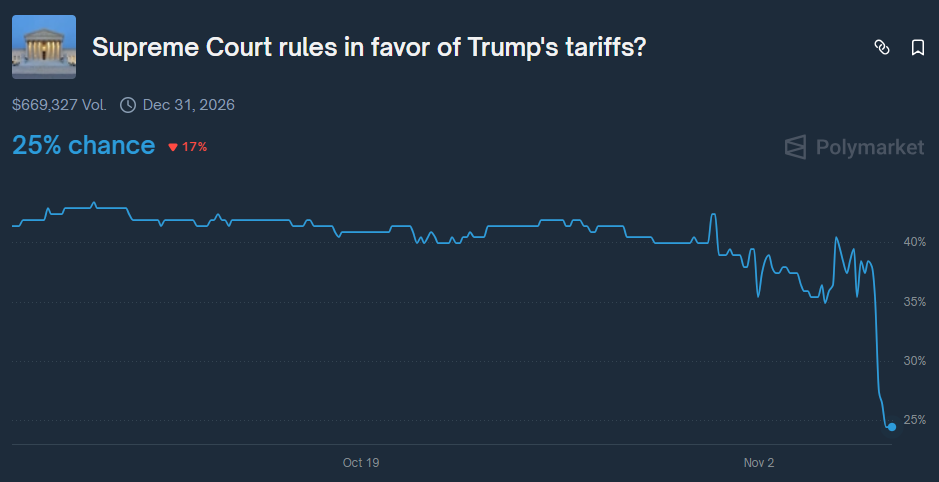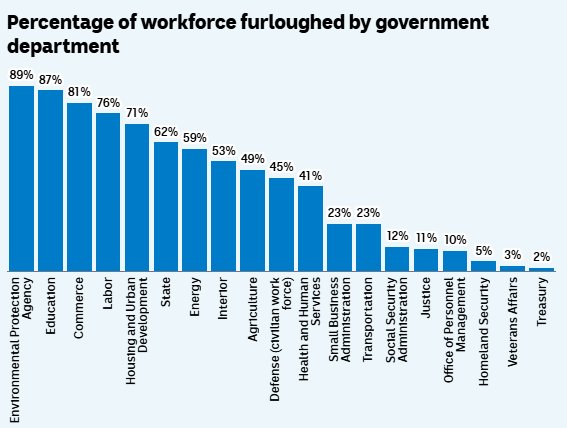Notícias de mercado & insights
Mantenha-se à frente dos mercados com insights de especialistas, notícias e análise técnica para orientar suas decisões de negociação.

Artificial intelligence stocks have begun to waver slightly, experiencing a selloff period in the first week of this month. The Nasdaq has fallen approximately 2%, wiping out around $500 billion in market value from top technology companies.

Palantir Technologies dropped nearly 8% despite beating Wall Street estimates and issuing strong guidance, highlighting growing investor concerns about stretched valuations in the AI sector.
Nvidia shares also fell roughly 4%, while the broader selloff extended to Asian markets, which experienced some of their sharpest declines since April.
Wall Street executives, including Morgan Stanley CEO Ted Pick and Goldman Sachs CEO David Solomon, warned of potential 10-20% drawdowns in equity markets over the coming year.
And Michael Burry, famous for predicting the 2008 housing crisis, recently revealed his $1.1 billion bet against both Nvidia and Palantir, further pushing the narrative that the AI rally may be overextended.
As we near 2026, the sentiment around AI is seemingly starting to shift, with investors beginning to seek evidence of tangible returns on the massive investments flowing into AI, rather than simply betting on future potential.
However, despite the recent turbulence, many are simply characterising this pullback as "healthy" profit-taking rather than a fundamental reassessment of AI's value.
Supreme Court Raises Doubts About Trump’s Tariffs
The US Supreme Court heard arguments overnight on the legality of President Donald Trump's "liberation day" tariffs, with judges from both sides of the political spectrum expressing scepticism about the presidential authority being claimed.
Trump has relied on a 1970s-era emergency law, the International Emergency Economic Powers Act (IEEPA), to impose sweeping tariffs on goods imported into the US.
At the centre of the case are two core questions: whether the IEEPA authorises these sweeping tariffs, and if so, whether Trump’s implementation is constitutional.
Chief Justice John Roberts and Justice Amy Coney Barrett indicated they may be inclined to strike down or curb the majority of the tariffs, while Justice Brett Kavanaugh questioned why no president before Trump had used this authority.
Prediction markets saw the probability of the court upholding the tariffs drop from 40% to 25% after the hearing.

The US government has collected $151 billion from customs duties in the second half of 2025 alone, a nearly 300% increase over the same period in 2024.
Should the court rule against the tariffs, potential refunds could reach approximately $100 billion.
The court has not indicated a date on which it will issue its final ruling, though the Trump administration has requested an expedited decision.
Shutdown Becomes Longest in US History
The US government shutdown entered its 36th day today, officially becoming the longest in history. It surpasses the previous 35-day record set during Trump's first term from December 2018 to January 2019.
The Senate has failed 14 times to advance spending legislation, falling short of the 60-vote supermajority by five votes in the most recent vote.
So far, approximately 670,000 federal employees have been furloughed, and 730,000 are currently working without pay. Over 1.3 million active-duty military personnel and 750,000 National Guard and reserve personnel are also working unpaid.

SNAP food stamp benefits ran out of funding on November 1 — something 42 million Americans rely on weekly. However, the Trump administration has committed to partial payments to subsidise the benefits, though delivery could take several weeks.
Flight disruptions have affected 3.2 million passengers, with staffing shortages hitting more than half of the nation's 30 major airports. Nearly 80% of New York's air traffic controllers are absent.
From a market perspective, each week of shutdown reduces GDP by approximately 0.1%. The Congressional Budget Office estimates the total cost of the shutdown will be between $7 billion and $14 billion, with the higher figure assuming an eight-week duration.
Consumer spending could drop by $30 billion if the eight-week duration is reached, according to White House economists, with potential GDP impacts of up to 2 percentage points total.


BioNTech SE (NASDAQ: BNTX) reported Q4 2022 financial results on Monday. The German pharmaceutical company reported revenue of $4.563 billion for the quarter, topping analyst estimate of $3.897 billion. Earnings per share (EPS) also beat analyst estimates at $9.876 per share vs. $8.296 EPS expected.
CEO commentary ''We made significant progress in 2022 by advancing our pipeline and launching the world’s first Omicron BA.4/BA.5 adapted bivalent COVID-19 vaccine. In addition, multiple new modalities achieved encouraging clinical data and we progressed nine new programs into clinical trials,'' said professor Ugur Sahin, M.D., CEO and Co-Founder of BioNTech said in a press release. ''As we look to 2023 and beyond, we plan to continue investing in our transformation with a focus on building commercial capabilities in oncology and working towards registrational trials. Our mid-term goal is to seek approval for multiple oncology products in cancer indications with high unmet medical need,'' he added.
The stock was down by -3.59% at market close on Tuesday at $123.19 per share. Stock performance 1 month: -5.55% 3 months: -29.76% Year-to-date: -17.72% 1 year: -25.70% BioNTech SE price targets HC Wainwright & Co.: $210 JP Morgan: $142 Goldman Sachs: $156 Morgan Stanley: $216 B of A Securities: $239 SVB Leerink: $224 Canaccord Genuity: $192 BioNTech SE is the 576 th largest company in the world with a market cap of $29.99 billion. You can trade BioNTech SE (NASDAQ: BNTX) and many other stocks from the NYSE, NASDAQ, HKEX, ASX, LSE and DE with GO Markets as a Share CFD.
Sources: BioNTech SE, TradingView, MarketWatch, MetaTrader 5, Benzinga, CompaniesMarketCap


This week, the Bank of Canada (BoC) released its decision to hold interest rates at the current level of 4.50%. In the rate statement, the BoC indicated that inflation has eased to 5.9%, and the expectation for weaker economic growth and a moderation of wage growth could see inflation continue on its downward trajectory. The BoC highlighted that it projects that CPI inflation could reach the 3% level by the middle of the year, with core inflation reaching the target level of 2% in time to come.
Following the release of the decision, the Canadian Dollar weakened, with the USDCAD trading higher to test the 1.38 round number resistance level. This move higher was compounded by the recent strength of the DXY, a result of Fed Chair Powell’s testimony where he indicated that the Federal Reserve was ready to speed up rate hikes if the data warranted. The USDCAD could continue with the uptrend to trade significantly higher toward the next key resistance level of 1.39, especially if the US Non-Farm employment change to be released on Friday is stronger than expected.
However, it is likely that the USDCAD could first retrace briefly to the 1.37 price level, which aligns with the 23.60% Fibonacci Retracement level before a continuation to the upside. This brief retracement is also supported by the Relative Strength Index (RSI) as it indicates a likelihood to turn down from the overbought region.


This week, the Australian Consumer Price Index (CPI) y/y data was released at 6.8% (Forecast: 7.2% Previous: 7.4%) which signals a slowdown in inflation growth. In addition, the consecutive release of lower-than-expected CPI data highlights the possibility of a new trend of decreasing inflation for the Australian economy. With the view that inflation has peaked and is possibly on a downturn, the Reserve Bank of Australia (RBA) could decide to pause further rate hikes at its upcoming cash rate decision on Tuesday next week.
Keeping interest rates at 3.60% could lead to the AUDUSD trading slightly lower. The AUDUSD is currently trading between the key resistance level of 0.6765 and the support level of 0.6565, with the formation of a bearish pennant. If the AUDUSD maintains below the resistance level, look for a potential breakout to the downside, to retest the key support level of 0.6565.
This move lower could be driven by the recovery in strength on the DXY and if the RBA decides to hold interest rates at 3.60%.


The Consumer Price Index (CPI) is an inflation indicator that is closely watched by the markets and policymakers as a gauge of economic fluctuation and price stability. Generally, central banks set and adjust their monetary policy mandate in order to achieve a target level of 2-3% which would allow for moderate growth in prices. As the major economies emerge from the cloud of the Covid pandemic, the new battle is for the central banks to bring down inflation.
The Reserve Bank of Australia (RBA) began on its path of aggressive interest rate hikes in May 2022 as the Australian CPI had been climbing steadily to reach 6% by that same period. However, despite the rate hikes, inflation continued to rise to a peak of 8.4% in December 2022. This week, the Australian CPI y/y data was released at 7.4% which highlights an easing in inflation growth, potentially a lagging impact from the cumulate interest rate increases from the RBA.
Immediately following the release of the CPI data, the AUDUSD spiked down from the 0.6730 level to retest the round number key support level of 0.67. However, as the RBA has indicated that “further increases in interest rates will be needed over the months ahead to ensure that inflation returns to target”, the current slowdown in inflation growth could provide the RBA with more confidence that rate increases could lead to it achieving its target. As a result, sustained moves to the downside have been limited as the market anticipates another 25bps rate hike to come in the following week.
The AUDUSD currently trades under the 0.6780 resistance area which coincides with the 23.8% Fibonacci retracement level. Anticipating a bullish correction to the upside, as markets expect further interest rate increases, look for the price to break above the resistance level and the bearish trendline to trade higher toward the next key resistance level of 0.6870. This potential move higher is also supported by a crossover on the Moving Average Convergence Divergence (MACD).


Options trading offers a multitude of strategies that cater to various market conditions and risk appetites. One such strategy that traders often employ is the "Long Butterfly Spread." In this article, we will delve into the intricacies of the Long Butterfly Spread, exploring its components, mechanics, and potential advantages. At its core, the Long Butterfly Spread is a neutral options strategy that traders utilize when they expect minimal price movement in the underlying asset.
It involves using a combination of long and short call or put options with the same expiration date but different strike prices. This strategy is particularly useful when you anticipate that the underlying asset will remain relatively stable within a specific range. To construct a Long Butterfly Spread, you'll need to execute three transactions with options contracts.
Let's break down the components: Buy Two Options: The first step involves buying two options contracts. These contracts should be of the same type, either both calls or both puts, and share the same expiration date. One of these options should be an "in-the-money" option, while the other should be an "out-of-the-money" option.
Sell One Option: The next step is to sell one options contract, which should be positioned between the two contracts purchased in the previous step. This sold option should have a strike price equidistant from the two bought options and, like them, should also have the same expiration date. Now, let's understand the mechanics of the Long Butterfly Spread and how it can generate profits: Profit Potential: The Long Butterfly Spread is designed to profit from minimal price movement in the underlying asset.
It thrives in a scenario where the underlying asset closes at the strike price of the options involved in the strategy at expiration. In such a case, the trader reaps the maximum profit, which is the difference between the two middle strike prices minus the initial cost of the strategy. Limited Risk: One of the key advantages of the Long Butterfly Spread is its limited risk profile.
The maximum potential loss is capped at the initial cost of establishing the strategy, making it a prudent choice for risk-averse traders. This risk limitation is due to the fact that the trader is simultaneously long and short options, which mitigates the potential for substantial losses. Breakeven Points: In a Long Butterfly Spread, there are two breakeven points.
The first breakeven point is below the lower strike price of the strategy, and the second breakeven point is above the higher strike price. As long as the underlying asset closes within this range at expiration, the trader will either realize a profit or minimize their loss. Implied Volatility Impact: Implied volatility plays a crucial role in the Long Butterfly Spread.
When implied volatility is low, it reduces the cost of the strategy, making it more attractive. Conversely, when implied volatility is high, the strategy's cost increases, potentially affecting the risk-reward ratio. Therefore, traders should carefully assess implied volatility before implementing this strategy.
Time Decay: Time decay, also known as theta decay, can work in favor of the Long Butterfly Spread. As time passes, the value of the options involved in the strategy erodes. This erosion can benefit the trader if the underlying asset remains within the desired range.
However, if the asset moves significantly, it may offset the time decay benefits. Scenario Analysis: Let's consider a practical example to illustrate the Long Butterfly Call Spread. Suppose you are trading Company XYZ's stock, which is currently trading at $100 per share.
You anticipate that the stock will remain stable in the near future and decide to implement a Long Butterfly Call Spread. Buy 1 XYZ $95 Call option for $6 (in-the-money). Sell 2 XYZ $100 Call options for $3 each (at-the-money).
Buy 1 XYZ $105 Call option for $1 (out-of-the-money). The total cost of this strategy is $1 (6 - 3 - 3 + 1). Now, let's examine the potential outcomes: If Company XYZ's stock closes at $100 at expiration, you will achieve the maximum profit of $4.
The $105 call option will expire worthless so you will lose the $1 you paid, the $95 call option will make a net loss of $1 ($6 cost -$5 profit) and two $100 call options will be worth $3 each. If the stock closes below $95 or above $105, the strategy will result in a maximum loss of $1, which is the initial cost. Any closing price between $95 and $105 will yield a profit or loss within this range, depending on the precise closing price.
In conclusion, the Long Butterfly Spread is a versatile options trading strategy that offers limited risk and profit potential in stable market conditions. It is a strategy that requires careful consideration of strike prices, implied volatility, and time decay. Traders should always conduct thorough analysis and risk management before implementing any options strategy, including the Long Butterfly Spread.
When used judiciously, this strategy can be a valuable addition to a trader's toolkit for capitalizing on low-volatility scenarios.


In the intricate realm of financial markets, options trading stands as a dynamic and multifaceted approach to profiting from market dynamics. Among the diverse range of options instruments, the call option emerges as a fundamental tool. In this article, we will delve into the concept of call options, examining their definition, mechanics, and significance in the context of options trading.
A call option fundamentally operates as a financial contract, conferring a valuable right upon the holder. This right, however, is not accompanied by any obligation to purchase a predetermined quantity of an underlying asset at a specific price known as the strike price, within a predetermined timeframe known as the expiration date. This underlying asset can encompass a wide array of financial instruments, including but not limited to stocks, bonds, commodities, or currencies.
The primary attraction of call options stems from their potential for substantial leverage. In contrast to direct ownership of the underlying asset, which necessitates the full market price, obtaining a call option requires the payment of a premium. This premium constitutes only a fraction of the actual asset cost, thereby allowing traders to control a more substantial position size with a relatively modest upfront investment.
Nevertheless, it is crucial to acknowledge that leverage can magnify both gains and losses, underscoring the critical importance of prudent risk management when trading call options. To comprehend the concept of call options fully, one must dissect their key components. At the core of a call option lies several essential elements: Underlying Asset: Call options derive their value from an underlying asset.
This asset could encompass anything from stocks to indices, commodities, or other financial instruments. Strike Price: The strike price serves as the anchor point for a call option. It represents the price at which the call option holder can exercise their right to purchase the underlying asset.
Importantly, the strike price remains constant throughout the option's lifespan. Expiration Date: Every call option carries a predetermined expiration date. Beyond this date, the option becomes void if not exercised.
These options can have varying expiration periods, ranging from a matter of days to several months or even longer. Premium: To acquire a call option, the buyer must pay a premium to the seller, also known as the option writer. The premium serves as the cost of obtaining the right to buy the underlying asset at the strike price.
To illustrate the mechanics of a call option, consider the following example: Suppose an investor believes that XYZ Company's stock, currently trading at $50 per share, will experience an upswing in the next three months. They decide to purchase a call option on XYZ with a strike price of $55 and a premium of $3. This call option grants the investor the right to buy 100 shares of XYZ Company at $55 per share at any point before the option's expiration date, set three months from the present.
Now, let's explore two possible scenarios: Scenario 1 - The Stock Price Rises: Should the price of XYZ Company's stock surge to $60 per share before the option's expiration, the call option holder can opt to exercise their option. This allows them to purchase 100 shares of XYZ at the agreed-upon strike price of $55 per share, despite the current market price of $60. This transaction yields a profit of $5 per share ($60 - $55), minus the initial premium of $3.
The investor ultimately realizes a net gain of $2 per share ($5 - $3), amounting to a total profit of $200 ($2 x 100). Scenario 2 - The Stock Price Stays Below the Strike Price: Conversely, if XYZ Company's stock price remains at or below the $55 strike price, or even declines, the call option holder is under no obligation to exercise the option. In such cases, the option expires worthless, and the maximum loss for the investor is limited to the premium paid, which in this instance amounts to $300 ($3 x 100).
It is essential to note that not all call options are exercised. In fact, many call options expire without being exercised, especially when the underlying asset does not move favorably or when exercising the option would result in a loss exceeding the premium paid. The decision to exercise or not to exercise a call option lies entirely with the option holder, adding a layer of flexibility to this financial instrument.
Call options find utility across a spectrum of investment strategies. Beyond speculative trading, they can serve as effective hedging tools. For instance, an equity investor concerned about a potential market downturn might purchase call options on an index to offset potential losses in their portfolio.
This strategy allows them to profit from the call options if the market experiences an upswing while limiting their losses if it takes a downturn. In conclusion, call options represent a pivotal component of options trading, offering traders and investors a powerful mechanism to capitalize on upward price movements in various assets. By grasping the fundamental elements of call options, including the underlying asset, strike price, expiration date, and premium, individuals can make informed decisions and implement strategies to align with their financial goals.
However, it's imperative to bear in mind that options trading involves inherent risks, necessitating proper education and risk management strategies before venturing into these markets.

